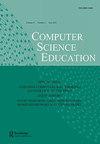Effects of different types of guidance on students’ motivation and learning in a remote laboratory in computer science
IF 2.2
Q1 EDUCATION & EDUCATIONAL RESEARCH
引用次数: 0
Abstract
ABSTRACT Background and Context During online learning, it is essential to provide instructional guidance to support learning. However, guidance can be given in different forms and quantities. Thus, one important challenge is to provide the right amount and type of instructional guidance. Objective The aim of the study is to investigate types of guidance which are effective for students with heterogenous programming knowledge and skills solving programming tasks in a remote laboratory. Method We carried out two studies with a single factor pre-post-design with guidance (basic/enhanced) as a between-subjects factor. Findings In study 1, we implemented enhanced guidance in the form of prompts in the introduction to the tasks. Whereas we found no differences in learning outcome or extraneous cognitive load, students in the enhanced guidance group reported less intrinsic motivation, and logfiles revealed a lower programming performance. In study 2, we implemented enhanced guidance in the form of adaptive just-in-time explanations for error streaks. Enhanced guidance led to a lower extraneous cognitive load, and this way increased learning outcome. Implications The type and timing of instructional guidance for students in computer science matters. More guidance is not better in each case. Instructional guidance should be tailored to students’ needs.不同类型的指导对计算机科学远程实验室学生学习动机的影响
背景与背景在在线学习过程中,提供教学指导以支持学习是必不可少的。然而,指导可以有不同的形式和数量。因此,一个重要的挑战是提供适当数量和类型的教学指导。目的探讨具有异质编程知识和技能的学生在远程实验室解决编程任务的有效指导类型。方法采用单因素前后设计,以指导(基本/强化)为被试间因素。在研究1中,我们在任务介绍中以提示的形式加强了指导。虽然我们没有发现学习结果或外部认知负荷的差异,但强化指导组的学生报告了较少的内在动机,并且日志文件显示了较低的编程性能。在研究2中,我们以自适应及时解释错误的形式实现了增强的指导。增强的指导可以降低外部认知负荷,从而提高学习效果。计算机科学学生教学指导的类型和时间很重要。在每种情况下,更多的指导并不是更好。教学指导应根据学生的需要量身定制。
本文章由计算机程序翻译,如有差异,请以英文原文为准。
求助全文
约1分钟内获得全文
求助全文
来源期刊

Computer Science Education
EDUCATION & EDUCATIONAL RESEARCH-
CiteScore
6.90
自引率
3.70%
发文量
23
期刊介绍:
Computer Science Education publishes high-quality papers with a specific focus on teaching and learning within the computing discipline. The journal seeks novel contributions that are accessible and of interest to researchers and practitioners alike. We invite work with learners of all ages and across both classroom and out-of-classroom learning contexts.
 求助内容:
求助内容: 应助结果提醒方式:
应助结果提醒方式:


